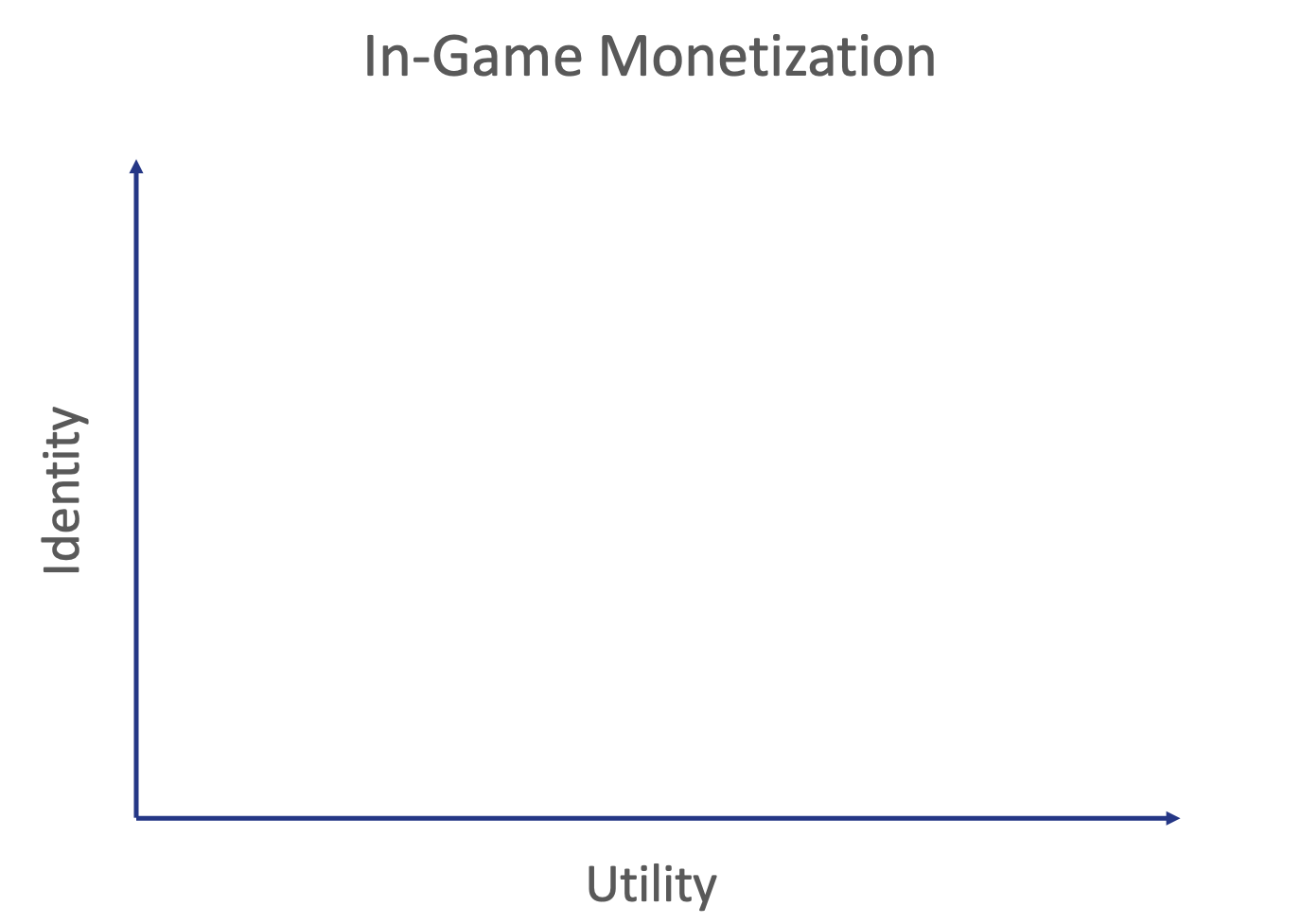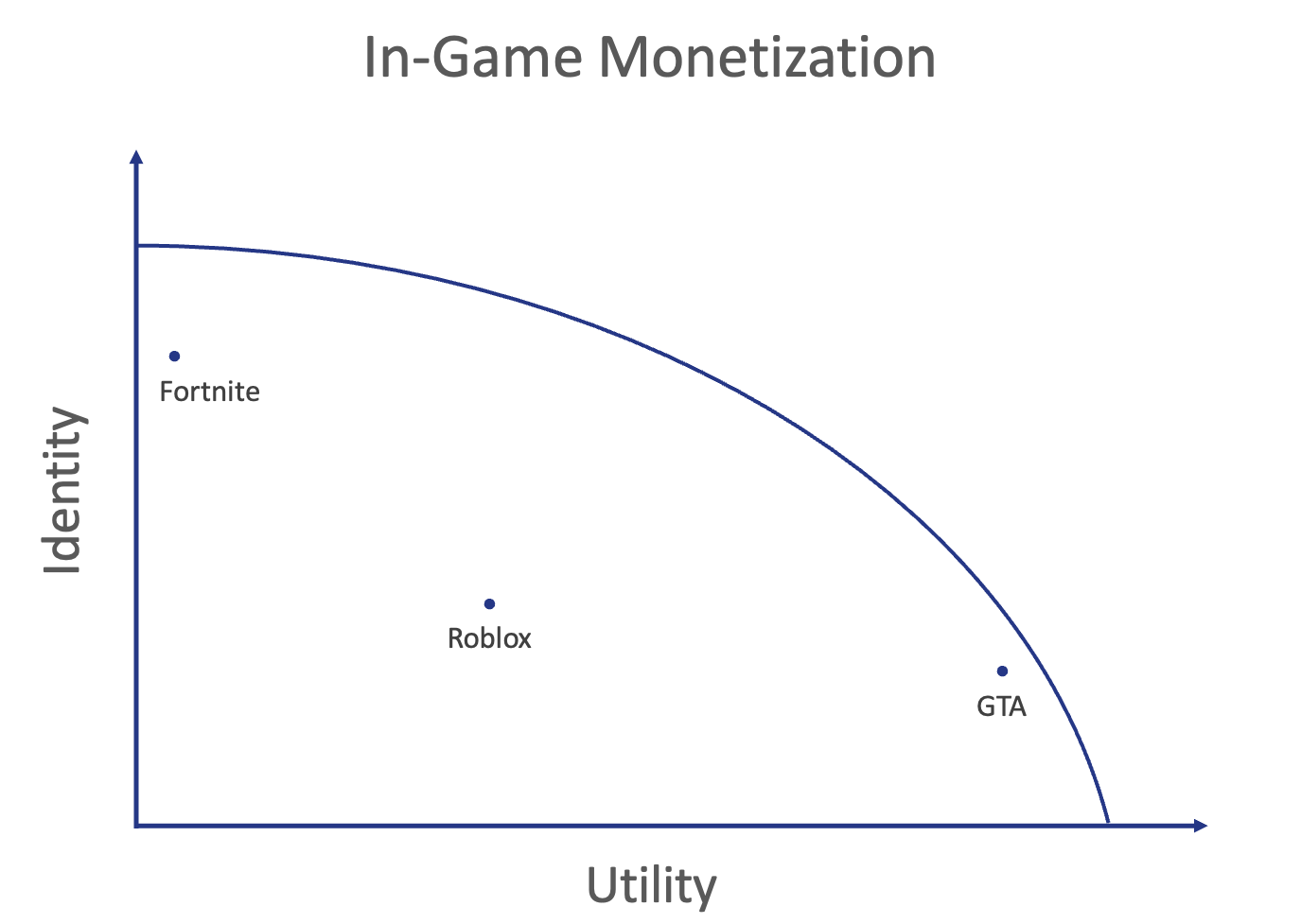From Steve’s blog, Aim Assist:
Lately, I’ve been thinking of a framework to use to better understand in-game monetization strategies and how they may ultimately apply to the Metaverse. Today, whether games are free-to-play or require a full game purchase, there are two different axis on which games can monetize recurrent consumer spending: identity and utility.

Identity is the degree to which purchases are cosmetic and aimed towards building someone’s online persona in a given world. When making purchases based on identity, players are rewarded with social credit in the game. These purchases offer no competitive advantage, but are important, nonetheless.
Utility is the degree to which the purchases have a competitive benefit in a given world. Utility purchases can give players a pure competitive advantage, but some of the more common utility purchases are those that save players time and advance them further in a game.
Three of the leading games building what appear to be early versions of the Metaverse are Fortnite, Roblox, and Grand Theft Auto, each finding a unique balance between identity and utility.

Fortnite’s monetization is based entirely on identity. The in-game purchases, whether skins, emotes, pickaxes, etc. offer no competitive advantage for players. Instead, anything purchased from the item shop is for social credit alone. Fortnite has done a great job of building scarcity into their item shop and typically offers items only for a limited time. In addition, they’ve been aggressive when it comes to IP partnerships, including items in their store from Marvel, D.C., Star Wars, Halo, and others. The dual nature of scarcity and popular culture crossovers has incentivized players to make purchases before they’re unable to. Fortnite also benefits as a third-person shooter, as users can see the skins they’re playing as, unlike many of the other popular first-person shooters it competes with.
Roblox strikes more of a balance monetizing through both identity and utility. Players can purchase outfits and animations, unique abilities, in-games, weapons, and more. Some purchases are purely cosmetic, while others offer a competitive advantage. In Roblox, monetization decisions are made by the individual developers themselves, rather than the company. Roblox sets a rate of USD to Robux, but developers are able to create their own offerings that may skew towards identity or utility in any given game.
Grand Theft Auto offers items that are primarily based on utility – apartments, vehicles, warehouses – all things that give players an advantage in the game. While you could argue there is an identity component to some of the items you can purchase, it’s typically not the primary reason why users spend real world dollars in the virtual world of GTA. GTA (and other Take-Two games NBA 2K and Red Dead Redemption) has built an incredible monetization engine. Players are able to purchase virtual currency to help them acquire in-game items necessary for advancement faster. It ultimately becomes a question of whether $20 is worth saving X hours of game time.
If the games are approaching monetization from different angles – what’s the best choice? We can look at average bookings per daily active user to give us a sense. Roblox reports the number quarterly and we’ve made estimates for Fortnite and Grand Theft Auto.

While Grand Theft Auto has truly impressive monetization numbers, it’s important to note that GTA has less than 10% of the DAUs as Fortnite and Roblox.

Of course, Grand Theft Auto requires an up-front purchase of the game and targets a much older audience. However, the players they do have are willing to spend money; a lot of money. It could be driven by the fact that they have an older player base (with more disposable income) or that their emphasis on utility is paying off.
Regardless, all three of these games have untapped opportunities for monetization, they aren’t at the frontier. Grand Theft Auto VI could see its number reach even higher if it can expand the importance on identity and incentivize players to make in-game purchases with that goal in mind. Fortnite could leverage its developer community and allow creators to monetize similar to the way Roblox developers do. Roblox could see higher monetization simply over time as its current user cohort ages and has a higher disposable income.
When it comes to the Metaverse, striking a balance between identity and utility is key. Players don’t want games or experiences they perceive as pay-to-win. On the other hand, GTA has shown how powerful monetizing utility can be. Higher monetization, whether accruing to a centralized developer or community of developers, can lead to a better product experience as the money is re-invested into different games and experiences. Ultimately, a successful Metaverse must have a virtuous cycle of mutual benefit where value grows for both the company and the users simultaneously. This is best achieved by carefully balancing both utility and identity.
